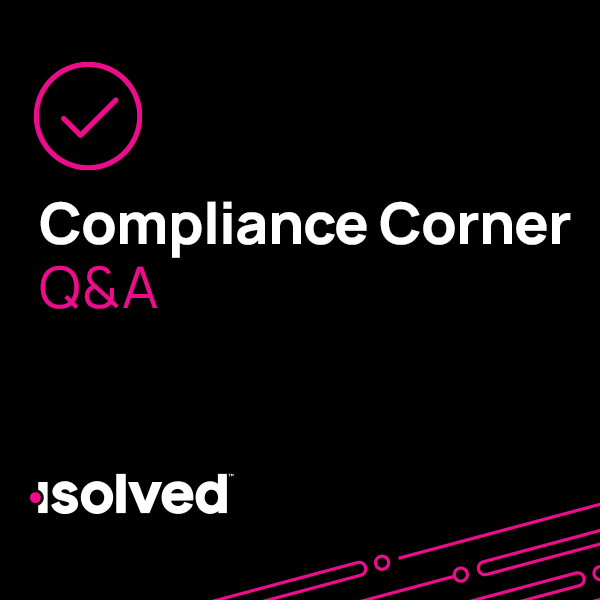Compliance Corner: Workers Opportunity Tax Credits--What Employers Need to Know
Friday March 31st, 2023
Estimated time to read: 2 minutes, 45 seconds

Organizations are constantly looking for ways to boost their bottom lines. Many can find savings through their employees and tax credits. In our latest Compliance Corner, our Senior HR Consultant Lisa Bright answers the top questions about Workers Opportunity Tax Credits.
What is the WOTC?
The Workers Opportunity Tax Credit (WOTC) is a Federal Government program that was created in 1996 to encourage employers to hire individuals in certain target groups who have consistently faced significant barriers to employment. Employers of any size are eligible for this program currently approved through December 2025.
Partnering with isolved can eliminate the complexity of the process and ensure employers are taking advantage of many of the WOTC incentives available.
What impact can it have on a business?
- The WOTC can reduce the overall cost of doing business by decreasing the employer’s federal income tax liability for each qualified hire in a targeted group.
- Companies can claim the credit for an unlimited number of qualified employees.
- Hiring eligible veterans can allow tax-exempt employers to receive credit on the employer’s share of Social Security tax.
- The WOTC enhances diversity within the organization while increasing overall productivity and engagement.
- It contributes to Corporate Social Responsibility by moving targeted works from economic dependency to self-sufficiency.
Which employees qualify for the credits?
- The largest group employers claim tax credits for under WOTC are receiving food stamps under the Supplemental Nutrition Assistance Program. This group qualifies for up to $2,400 in tax credits per year.
- The second most common group are people receiving Temporary Assistance for Needy Families (TANF), qualifying for yearly tax credits up to $2,400 or $9,000 for long-term assistance recipients.
- Designated Community Residents between the ages of 18-39 living in an Empowerment Zone or Rural Renewal County, which are rural areas away from employment opportunities, qualify employers for a tax credit of up to $2,400.
- Ex-felons who are hired within one year of conviction or having served time in prison qualify for $2,400 in tax credit.
- Those who are over 65, blind or disabled can qualify for as much as $2,400 in tax credit.
- Hiring someone who has been on unemployment for at least 27 consecutive weeks or 6 months can earn the employer a tax credit of $2,400.
- Veterans provide the largest tax credit, earning $9,600. To qualify, they must be out of duty for at least two months and have either: received food stamps, a disability, been unemployed for at least one month or received unemployment for at least six months during the prior year.
- Individuals who are in a Vocational Rehab Referral Program or a Summer Youth Employee may also qualify for up to $2,400 in tax credits.
Using the isolved WOTC feature makes this process simple for employers by ensuring new hires complete the WOTC screening. The WOTC team will review forms for qualifications and send them to the appropriate state for certification. isolved ensures that when hours/wages are collected quarterly, the WOTC credits are processed with a summary of credit that is provided to the employer.
What’s the maximum an employer can earn?
Employers can claim up to as much as $9,600 in credit for each qualifying new hire.
In the first year of employment, individuals who work at least 400 hours can earn an employer 40% of $6,000 in paid wages. Employers can claim 25% of wages on individuals working fewer than 400 but more than 120 hours. Employers can earn up to $24,000 in wages when hiring certain qualified veterans.
Can you ask questions to potential employees about WOTC eligibility?
Employers are required to pre-screen and obtain certification through a State Workforce Agency, either on the day of or before an offer of employment is made, for everyone of a targeted group.
Employers should collect the information needed to identify candidates either during the hiring process or during onboarding. All qualifying questions on Form 8850 comply with federal EEO laws when used properly and are always voluntary.
To ensure compliance, the isolved onboarding feature allows new hires to complete the questionnaire needed to determine eligibility for the WOTC tax credit, obtains electronic signatures and eliminates storage of paper forms.
What’s the best way for a business to reap the benefits of WOTC?
The fastest and easiest way for an employer to maximize the tax credit benefit of the WOTC is by partnering with a service provider who has experience with various industries across the country. Using isolved technology to streamline the process, employers can increase their bottom line by reducing federal income tax liability.
Looking to capitalize on WOTC opportunities? isolved HR Services can help.
About Lisa:

Lisa serves on the isolved HR Services team as a Senior HR Consultant, bringing more than 20 years of experience in HR. She has supported a variety of industries including healthcare, manufacturing, education and preferred employer organizations. Her areas of expertise include compensation and benefits, policy compliance, employee relations and performance management.
